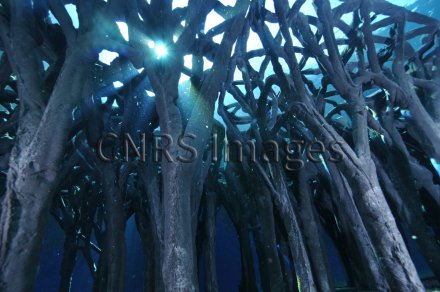Research program(s)
Production year
2020

© Dorian GUILLEMAIN / OSU Pythéas / CNRS Images
20230006_0004
Intérieur de BathyReef durant un test en bassin. Le récif artificiel bioinspiré BathyReef est un colonisateur en béton dont la forme s’inspire des ascidies, un animal vivant dans les fonds marins. Il est testé à quelques mètres de profondeur avant de le déployer sur le site de l’observatoire sous-marin EMSO-LO, à 2 500 m de profondeur au large de Toulon, avec le rover sous-marin benthique BathyBot. Ce robot suivra sur plusieurs années l’environnement, la biodiversité et les potentiels impacts du changement climatique dans les grands fonds. Au fil du temps, BathyReef sera progressivement colonisé par les organismes benthiques, créant un point de biodiversité qui pourra être observé par BathyBot. La forme du récif artificiel permettra aussi au robot de s’en servir de rampe pour augmenter son champ d’observation. BathyReef a été conceptualisé par le cabinet d’architectes Rougerie+Tangram avec les contraintes technique et scientifique dictées par l'Institut méditerranéen d'océanologie (MIO) et la Division technique de l'INSU du CNRS. Il a été fabriqué par la société Vicat par impression 3D du béton en différents modules.
The use of media visible on the CNRS Images Platform can be granted on request. Any reproduction or representation is forbidden without prior authorization from CNRS Images (except for resources under Creative Commons license).
No modification of an image may be made without the prior consent of CNRS Images.
No use of an image for advertising purposes or distribution to a third party may be made without the prior agreement of CNRS Images.
For more information, please consult our general conditions
2020
Our work is guided by the way scientists question the world around them and we translate their research into images to help people to understand the world better and to awaken their curiosity and wonderment.